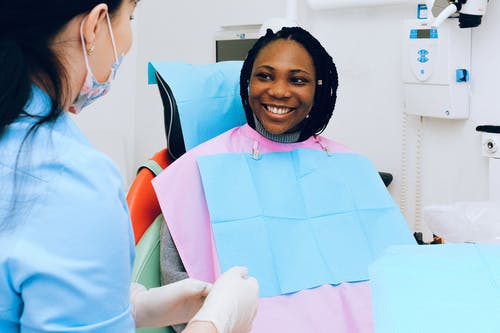Dental x-rays, or radiographs, are crucial to any dental care treatment plan. They are diagnostic but can also be preventative by helping a dentist diagnose potential oral care issues in a patient’s mouth before they become a major problem.
What Information Do Dental X-Rays Provide?
An X-ray is a type of energy that passes through soft tissues and is absorbed by dense tissue. Teeth and bone are very dense, so they absorb X-rays, while X-rays pass more easily through gums and cheeks. Because of this, dental x-rays can provide much information that may not be visible from the surface.
1. Tooth Decay Detection
Dental X-rays reveal cavities that may be hidden between teeth or under existing dental work. These interproximal cavities can be challenging to identify through visual inspection alone, especially in areas where teeth are closely positioned. X-rays help dentists detect early-stage decay, enabling them to address the issue before it worsens and requires more extensive treatment.
2. Bone Health
X-rays provide insights into the density and structure of the underlying jawbone. This is particularly important in cases of periodontal disease, which can lead to bone loss around teeth. By examining X-rays, dentists can gauge the severity of bone loss and determine the appropriate treatment approach. Additionally, X-rays are essential when considering dental implants, as they help dentists assess the bone’s suitability for implant placement.
3. Gum Health
Changes in bone levels around teeth are indicative of gum disease progression. Dental X-rays show the extent of bone loss and aid in diagnosing periodontal disease. This information guides dentists in devising effective treatment plans to manage and prevent further damage to the gums and supporting structures.
4. Impacted Teeth
Wisdom teeth (third molars) often become impacted due to insufficient space in the jaw. Dental X-rays reveal the position and orientation of impacted teeth. This information assists dentists in determining whether extraction is necessary to prevent pain, infection, and potential complications.
5. Alignment and Bite
X-rays aid in evaluating the alignment of teeth and detecting issues with the bite, such as overbites, underbites, and crossbites. These assessments are crucial for orthodontic treatments, as they inform the design of braces or aligners to achieve proper tooth alignment and bite function.
6. Abscesses and Infections
Dental X-rays help identify dental abscesses, infections, or cysts that may be present around the roots of teeth or in the jawbone. Timely detection of these issues is crucial to prevent the spread of infection and to address the underlying causes.
7. Tumor Detection
X-rays assist in detecting abnormalities, growths, or tumors in the oral and facial regions. Detecting such issues early is essential for prompt medical intervention and treatment.
8. Monitoring Development
In children, dental X-rays aid in tracking the development of permanent teeth. This ensures that teeth erupt in the correct position and sequence and that any developmental issues can be addressed promptly.
9. Follow-up and Progress Tracking
X-rays taken over time allow dentists to monitor the progress of ongoing treatments. For instance, after orthodontic interventions, X-rays help dentists assess how teeth are shifting and if the treatment is progressing as intended. Similarly, X-rays aid in evaluating the success of procedures like root canals or dental restorations.
Teeth Cleaning and Dental X-Rays
The combination of a teeth cleaning process and a dental x-ray is a key part of maintaining your oral health. Initially, the dentist does a visual examination, including an oral cancer screening and checking your face, neck, lips, tongue, throat, tissues, and gums for any signs of oral cancer. Next, an advanced dental X-ray is performed. This can help the dentist to see any signs of decay, disease, or injury.
Are Dental X-Rays Safe?
Modern technology has drastically reduced the radiation dosage. Remembering that a periodic dental X-ray is safe and a much-needed investment for oral health is also important. These X-rays use very low radiation levels and are safe for almost everyone. The American Dental Association states you are exposed to more radiation by simply being outdoors or at home than you are exposed to during a dental radiograph.
Pregnancy and X-Rays
If you are pregnant, always inform your dentist. While the radiation from a dental x-ray is extremely low, as a precaution, your dentist may decide to postpone any x-rays until after your pregnancy, or they may choose to proceed but use a leaded apron and thyroid collar for additional protection.
Proper X-Ray Frequency
The frequency of obtaining dental x-rays depends on the patient’s health condition. For instance, individuals with a high decay rate would need more frequent dental x-rays. Your dentist can discuss the proper frequency based on your oral health.
Other Dental Services
Comprehensive Dental Care
In the realm of dental care, comprehensive care goes beyond basic treatment. Instead, it combines preventative, periodontal, and restorative treatments. These comprehensive dental services aim to help you detect any dental issues early, maintain your oral health, restore your smile, and enhance your overall health.
Orthodontics Treatment
Orthodontics is a field of dentistry that deals with preventing and correcting irregularities of the teeth and jaws. It involves using appliances such as braces and retainers and is vital in correcting malocclusion (bad bites) and teeth alignment. Many dental health providers offer gentle orthodontic treatment to make this process faster, more comfortable, and less painful.
Conclusion
Overall, dental X-rays are a powerful diagnostic tool that enables dentists to provide accurate diagnoses, develop effective treatment plans, and ensure patients’ long-term oral health. It’s important to note that dentists follow established guidelines to ensure X-rays are recommended only when necessary, and they take precautions to minimize radiation exposure while maximizing the benefits of diagnostic information.





